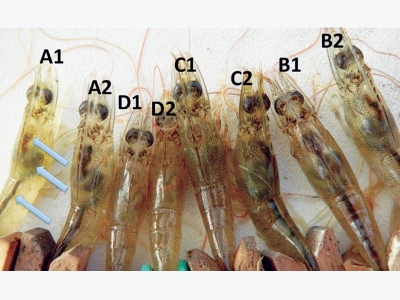Tilapia could enhance water conditions, help control EMS
Ten days after exposure to pathogenic Vibrio parahaemolyticus, shrimp A1, A2, C2, B1 and B2 show normal stomachs,hepatopancreases and midguts
 The Truth About Norwegian Farm-Raised Salmon
The Truth About Norwegian Farm-Raised Salmon Separate facts from fiction about farm-raised salmon and see how the Norwegian aquaculture industry sets the standard for high-quality farmed salmon.
 Watching ocean currents may limit disease spread on salmon farms
Watching ocean currents may limit disease spread on salmon farms Pancreas disease is a viral infection in farmed salmon that causes major economic losses because it reduces how much the fish grow and increases mortality
 Farmed fish don’t need to eat fish
Farmed fish don’t need to eat fish Fish in the sea are a limited resource. Thus, there will be increasing competition for using the fish in food for humans, farmed fish and farm animals.
 Coastal streams spread virus between farmed fish
Coastal streams spread virus between farmed fish The spread of pancreas disease between farms can be best explained by the direction of surface ocean currents.
 Acid salts and heat give better fish feed
Acid salts and heat give better fish feed Salmon and rainbow trout digest protein in plant-based feed better with inclusion of acid salts in combination with high temperature during extrusion.
 How environmental and dietary changes affect farmed fish
How environmental and dietary changes affect farmed fish Aquaculture diet has become increasingly plant based. In addition, the industry faces environmental changes
 Fish farming in the Amazon
Fish farming in the Amazon Brazil looks to Norway to modernize and upscale their own fish aquaculture industry.
 How to make the fish farming industry more climate friendly
How to make the fish farming industry more climate friendly A new Master's thesis shows that a renewable wind and solar energy solution can cut emissions by 50 per cent and at the same time increase profitability.
 3D-scans may help curb widespread fish disease
3D-scans may help curb widespread fish disease The bacterium that causes enteric redmouth disease can now be tracked with a special 3D scanner. “The scans exceed our wildest dreams,” say researchers.
 Swine liver hydrolyzate could work as a substitute for fishmeal in fish feeds
Swine liver hydrolyzate could work as a substitute for fishmeal in fish feeds Swine liver hydrolyzate can be included in carnivorous fish diets but free amino acids limits the inclusion level, say researchers.
 Yeast digestibility hinders effectiveness of novel protein based fish feed
Yeast digestibility hinders effectiveness of novel protein based fish feed Research, just published, evaluating a mussel and yeast based feed for Arctic charr found it restricted fish growth.
 Functional fish feeds, gut health, novel proteins: experts to weigh in on hot topics
Functional fish feeds, gut health, novel proteins: experts to weigh in on hot topics We will hear how nutrigenomics can foster sustainable aquaculture, along with a new model to evaluate gut health and growth in salmon.
 High-oil residue camelina may support growth in farmed rainbow trout
High-oil residue camelina may support growth in farmed rainbow trout A dietary inclusion level of 80 g/kg high oil camelina meal is acceptable in juvenile rainbow trout diets, find researchers.
 Plant based salmon feeds could be lacking in nutrients
Plant based salmon feeds could be lacking in nutrients Recommendations on vitamin and mineral supplements in the feed for Atlantic salmon need updating, says Norway's National Institute of Nutrition and Seafood
 Low-cost enzymes may offer digestion boost to tilapia
Low-cost enzymes may offer digestion boost to tilapia Soybean meal and low-cost enzymes use may offer boost to tilapia production, though results differ when alternative plant proteins are used, say researchers.
 Nile tilapia farmed in cold water may see performance boost from added α-linolenic acid
Nile tilapia farmed in cold water may see performance boost from added α-linolenic acid Raising levels of α-linolenic acid in tilapia diets may improve growth, weight gain and feed efficiency in a cold-water environment, say researchers.
 Using pre-gelatinized starch in aqua diets may boost tilapia growth, performance
Using pre-gelatinized starch in aqua diets may boost tilapia growth, performance Pre-gelatinized starch may offer a growth boost to fish and improve pellet characteristics, say researchers.
 What environmental or dietary factors play a role in modifying amino acid requirements
What environmental or dietary factors play a role in modifying amino acid requirements What environmental or dietary factors play a role in modifying amino acid requirements in farmed tilapia?
 Sorghum could substitute cassava as starch source for feeding Pangasius in Vietnam
Sorghum could substitute cassava as starch source for feeding Pangasius in Vietnam The effort found that the sorghum diet was equally palatable to the fish and that it supported production similar to a cassava diet, said report authors.
